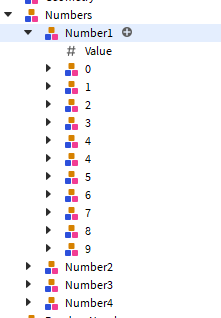Hello forumers! I was coding a quick puzzle system, and when I went to compare two tables, despite the indices checked being (I think) equivalent, the code believes they are not. If I am understanding the jargon, I am comparing two nodes, which have the same integers, but are being passed as inequivalent. I’ve been stuck on this for a while and thought seeking professional input would be the best action. The code is pasted below, and please bear with the inefficiency of it, it’s a miracle it works.
--Text here isn't relevant, just for continuity
local tweenservice = game:GetService("TweenService")
local soundservice = game:GetService("SoundService")
local braam = soundservice["DARK BRAAM 01"]:Clone()
braam.Parent = script.Parent.PrimaryPart
braam.PlaybackSpeed = 0.8
braam.Volume = 1.5
local puzzle = script.Parent
local numbers = puzzle.Numbers
local randomnumbers = puzzle.RandomNumbers
local mouseclick1 = puzzle.Joystick1:WaitForChild("ClickDetector")
local mouseclick2 = puzzle.Joystick2:WaitForChild("ClickDetector")
local mouseclick3 = puzzle.Joystick3:WaitForChild("ClickDetector")
local mouseclick4 = puzzle.Joystick4:WaitForChild("ClickDetector")
local mouseclickbutton = puzzle.Button.ClickDetector
local tablecolors = {
Color3.new(1, 0.666667, 0),
Color3.new(0.666667, 0, 1),
Color3.new(0.666667, 1, 1)
}
local tableoperations = {
Color3.new(0, 1, 0),
Color3.new(1, 1, 0)
}
local codetable = {}
local attempttable = {}
local sumtotal = 5
--Creating randomized color sequences, and finding a result
local function gencode(numberpair)
if sumtotal ~= 5 then
sumtotal = 5
end
local operation
if numberpair ~= nil then
for _, v in ipairs (numberpair:GetChildren()) do
local colorrand = tablecolors[math.random(1, #tablecolors)]
local coloropp = tableoperations[math.random(1, #tableoperations)]
if v.Name == "Part" then
local number = v:FindFirstChild("NumberValue")
v.Color = colorrand
if v.Color == Color3.fromRGB(255, 170, 0) then
number.Value = 1
end
if v.Color == Color3.fromRGB(170, 0, 255) then
number.Value = 2
end
if v.Color == Color3.fromRGB(170, 255, 255) then
number.Value = 0
end
else
local bool = v:FindFirstChild("BoolValue")
operation = v
v.Color = coloropp
if v.Color == Color3.new(0, 1, 0) then
bool.Value = true
end
if v.Color == Color3.new(1, 1, 0) then
bool.Value = false
end
end
end
for _, v in ipairs(numberpair:GetDescendants()) do
if v.Name == "NumberValue" then
local op = operation.BoolValue
if op.Value == true then
sumtotal -= v.Value
else
sumtotal += v.Value
end
end
end
return sumtotal
end
end
--Creates the newly randomized combination from random colors
for _, v in ipairs(randomnumbers:GetChildren()) do
local attribute = v:GetAttribute("Order")
local value = gencode(v)
table.insert(codetable, {attribute, value})
end
for _, v in ipairs(codetable) do
print(_, v)
end
local tablenumbers = {}
--Puzzle-solving mechanism
local function createnumber(nixietube, joystick)
local tubeselect = nixietube
if tubeselect ~= nil then
local axis = joystick.PrimaryPart
local tweeninfo = TweenInfo.new(0.25, Enum.EasingStyle.Quart, Enum.EasingDirection.Out, 0, true, 0.1)
local tweentable = {CFrame = axis.CFrame * CFrame.Angles(0, 0, math.rad(-30))}
local tween = tweenservice:Create(axis, tweeninfo, tweentable)
tween:Play()
tween.Completed:Connect(function()
local value = tubeselect:FindFirstChild("Value")
value.Value += 1
if value.Value > 9 then
value.Value = 0
end
for _, v in ipairs (tubeselect:GetChildren()) do
if tonumber(v.Name) == value.Value then
local meshnumber = v:FindFirstChildWhichIsA("MeshPart")
meshnumber.Color = Color3.fromRGB(188, 110, 61)
meshnumber.Transparency = 0
end
if tonumber(v.Name) == value.Value - 1 or tonumber(v.Name) == value.Value + 9 then
local meshnumber2 = v:FindFirstChildWhichIsA("MeshPart")
meshnumber2.Color = Color3.fromRGB(43, 25, 14)
meshnumber2.Transparency = 0.8
end
end
end)
end
end
--Resets puzzle
for _, v in ipairs(puzzle.Numbers:GetDescendants()) do
if v:IsA("MeshPart") and v.Name ~= "zero" then
v.Color = Color3.fromRGB(43, 25, 14)
v.Transparency = 0.8
end
end
--Checks if the puzzle solution inputted matches the code
local function solvepuzzle()
local tblcode = {}
local tblattempt = {}
for _, v in ipairs(numbers:GetDescendants()) do
if v:IsA("NumberValue") then
local order = v.Parent:GetAttribute("Order")
local valueattempt = v.Value
table.insert(attempttable, {order, valueattempt})
end
end
table.sort(codetable, function(a, b)
return a[1] < b[1]
end)
table.sort(attempttable, function(a, b)
return a[1] < b[1]
end)
--[[Problems arise here, the print says that both tables give the same node (when solved correctly), yet the code treats them as not being equal. For example, if the code yields:
▼ {
[1] = 1,
[2] = 8
} ▼ {
[1] = 1,
[2] = 8
}
It will still pass the inequality statement as true.]]
for i, v in pairs(codetable) do
print(attempttable[i], v)
if attempttable[i] ~= v then
return print("fail")
end
end
for i, v in pairs(attempttable) do
print(codetable[i], v)
if codetable[i] ~= v then
return print("fail")
end
end
braam:Play()
return print("successful")
end
--Connects
mouseclick1.MouseClick:Connect(function()
createnumber(numbers.Number1, puzzle.Joystick1)
end)
mouseclick2.MouseClick:Connect(function()
createnumber(numbers.Number2, puzzle.Joystick2)
end)
mouseclick3.MouseClick:Connect(function()
createnumber(numbers.Number3, puzzle.Joystick3)
end)
mouseclick4.MouseClick:Connect(function()
createnumber(numbers.Number4, puzzle.Joystick4)
end)
mouseclickbutton.MouseClick:Connect(function()
solvepuzzle()
end)
Sorry, I know this is a lot of code, but any input at all would be greatly appreciated!


